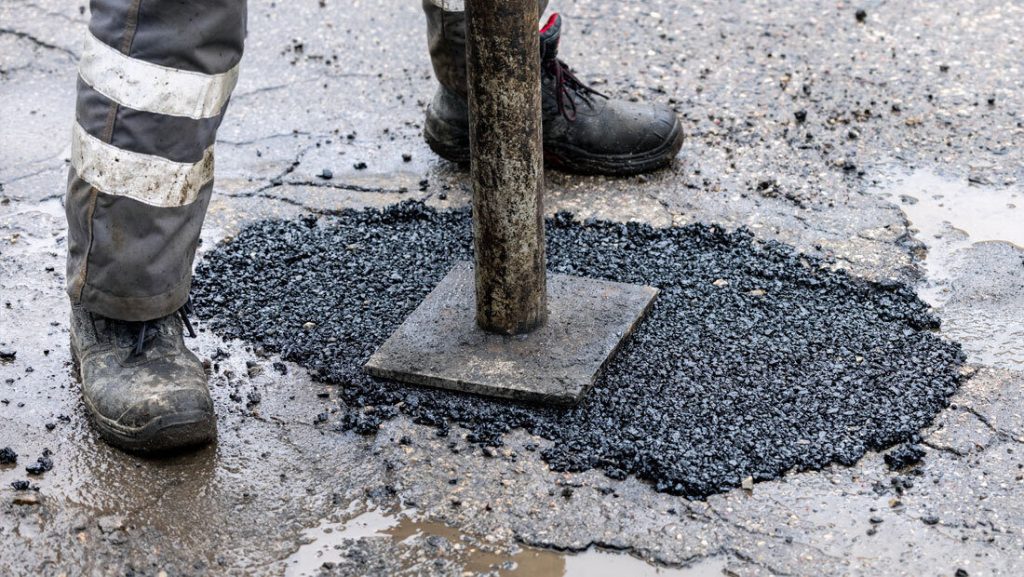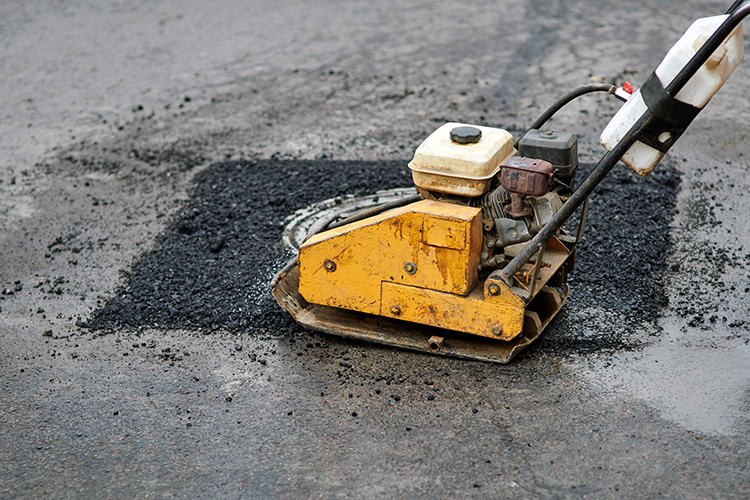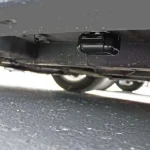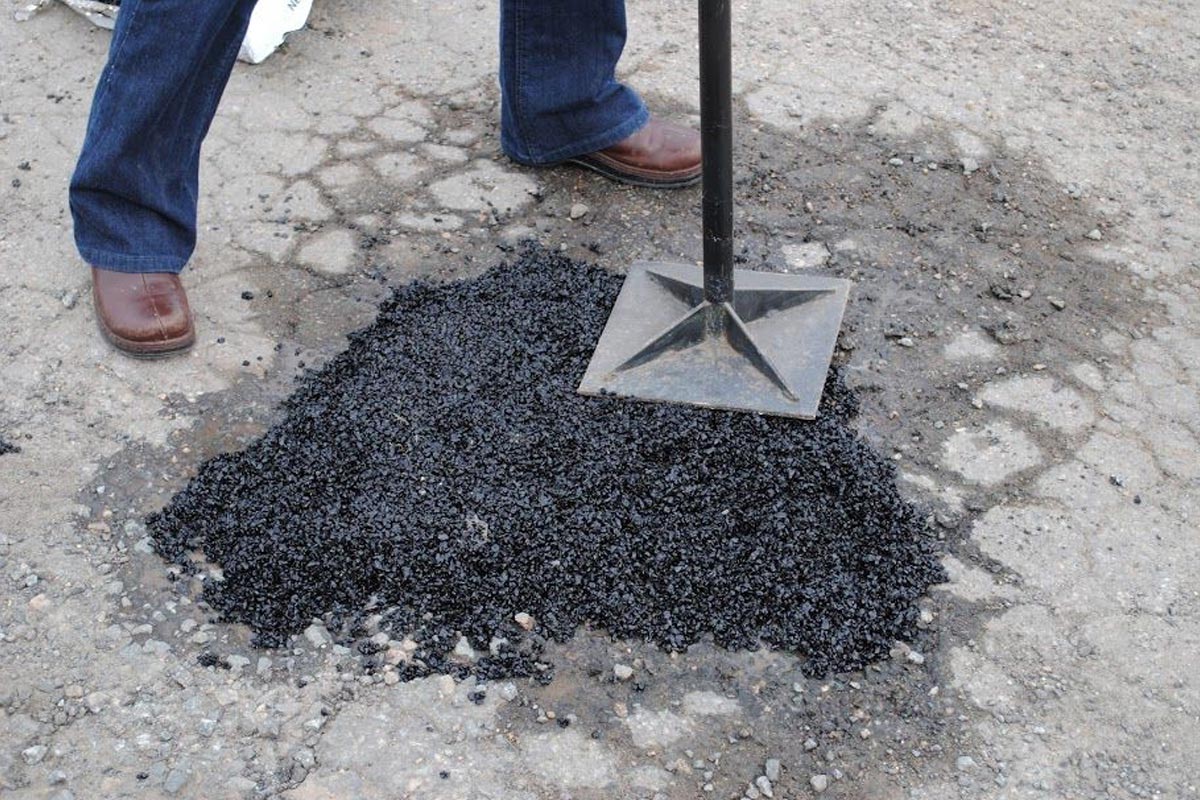Today, you’re diving into the art of pothole patching on a budget. Because they can be the bane of our existence, but fear not, for we’ve got the inside scoop on the cheapest way to tackle these asphalt abysses.
However, the most economical method for filling potholes is by utilizing loose gravel. It’s a quick and inexpensive solution, though it comes with the drawback of needing regular replenishment as the gravel breaks down and disperses.
On the other hand, cold mix asphalt is another cost-effective alternative, providing a temporary fix for smaller potholes, loose gravel stands out as the cheapest and easiest approach, despite the need for ongoing maintenance.
Optimal Materials for Pothole Repair: A Comprehensive Analysis

Concrete: The Permanence Challenge
- Concrete’s popularity stems from its durability, yet it poses challenges, requiring resealing every 5 years.
- Vulnerabilities in cold temperatures, brittleness, and impermeability contribute to cracking and runoff issues.
- Full-surface replacement is essential to mitigate erosion, but the high cost and time-intensive installation deter many.
Loose Gravel: Quick, Cheap, but Constant Maintenance
- The cheapest and quickest option for pothole filling, but with a caveat.
- Rapid breakdown and spreading necessitate continuous replenishment.
- While cost-effective initially, the perpetual need for additional gravel increases long-term expenses.
Asphalt: Durability Tempered by Maintenance
- Comparable to concrete but with a longer lifespan.
- Requires resealing every 5 years to prevent water intrusion.
- Vulnerability to hot temperatures, impermeability, and runoff concerns add to maintenance costs.
Permeable Pavers: The Ultimate Pothole Solution
- Exceptional durability, cost-effectiveness, and permeability define permeable pavers.
- For your easiness you can check TRUEGRID PRO-LITE and TRUEGRID PRO PLUS boast 100% permeability, allowing efficient water drainage.
- Quick and straightforward installation, completed in less than a day.
- Immune to shifting, sinking, cracking, or warping due to installation over a gravel sub-base.
- Crafted from 100% recycled plastic, TRUEGRID pavers exemplify eco-friendliness.
- Remarkable longevity lasting up to 60 years with minimal maintenance.
- Capable of withstanding heavy vehicle traffic, even the weight of a monster truck.
- Gravel-filled surface prevents migration or degradation, ensuring a durable and sustainable solution.
Mastering Pothole Repair: A Step-by-Step Guide
Part 1: Cleaning and Cutting the Hole
Precision Cutting with a Wet Saw
- Utilize safety gear such as gloves, protective eyewear, and a dust mask.
- Employ a wet saw with a diamond blade to cut around the edges, creating a symmetrical shape.
- Optional: Shape the edges into a circle, square, or rectangle for ease.
- Debris Removal
- Remove larger rocks and debris from the hole, maintaining safety precautions.
- Discard items into a designated disposal pile.
- Digging Soft Debris
- Use a shovel or trowel to remove soft debris, ensuring a firm foundation.
- Optional: Pour soft debris into the same disposal pile for efficiency.
- Absorbing Water
- Address any water accumulation with absorbent rags to enhance the repair’s longevity.
- For puddles, use a wet/dry shop vac for efficient drainage.
- Sweeping the Surrounding Area
- Ensure a clean work environment by sweeping away pebbles, dirt, and dust from the hole’s surroundings.
Part 2: Adding Your Paver Base
- Acquiring Paver Base
- Visit a construction supply store to purchase paver base, a cost-effective combination of crushed stone and sand.
- Estimate quantity visually, considering potential compaction.
- Filling the Hole
- Pour the paver base into the hole, filling the bottom 2–4 inches by hand.
- Wear gloves for safety.
- Compacting with a Tamper
- Use a tamper to compact the paver base by hitting it 5-10 times, repeating until within 2 inches of the top.
- Take breaks every 10-15 minutes to prevent exhaustion.
Part 3: Filling in the Pothole with Blacktop
Obtaining Cold Patch Blacktop Repair
- Purchase enough cold patch blacktop repair from a construction supply store.
- Look for DOT-approved brands for high-quality results.
Filling the Hole
- Invert the container over the pothole, tapping to release the blacktop.
- Thick consistency may require assistance with a hammer or putty knife.
Spreading with Precision
- Use a hard putty knife or shovel to spread the blacktop evenly over the pothole’s surface.
Adjusting Height
- Add or remove the blacktop to achieve a 1⁄2–1 inch protrusion beyond the surrounding asphalt.
Tampering for Compactness
- Employ the tamper to compact the blacktop similarly to the paver base, ensuring a flush finish.
Curing Period
- Allow a minimum of 3-4 weeks for the repair to cure before driving or walking over it.
Alternative Ways You Can Use To Fix Potholes

Fixing potholes is a must, but sometimes time and money are tight. Here are clever ways to patch them up until you can get a pro to tackle the job.
- DIY Asphalt Sealing:
- Feeling crafty? Try DIY sealants they’re like what the pros use but without the hefty cost. Just know, they might not be as top-notch.
- Compress Asphalt:
- Keep it budget-friendly. Grab some asphalt, fill the hole, and squish it down with something hefty could be a big rock or your car wheels. It’s a quick fix that’s easy to undo when the experts step in.
- Cover it Up:
- Super simple. Use what you have—tarp, plywood—to shield the pothole. Safety first, though! Block it off so no accidents happen. But remember, this is a short-term fix. Get a pro pronto.
Quick fixes are cool, but a pro touch is the real deal for a lasting solution. Stay safe!
FAQ’s
What is the best material to fill potholes with?
The best material for potholes is asphalt millings, a durable mix of asphalt cement and aggregates, ideal for high-traffic areas.
How do you fill potholes at home?
You can fix potholes at home by using a cold tar mix and compacting it to allow stone chips to bind for a DIY solution.
What is the best product for potholes?
The top product for pothole repair is cold-mixed asphalt with a polymer adhesive, ensuring permanent and effective repairs.
What are the methods of fixing potholes?
Various methods include throw-and-roll, full-depth roadway repair, semi-permanent repair, edge seals, and spray injection for different pothole fixes.
Can cement be used to fill potholes?
Yes, concrete is a durable option for filling potholes as it provides a permanent solution compared to gravel, which tends to spread.
How hard is it to fix a pothole?
Fixing a pothole is surprisingly easy and can be done in a few hours by individuals, not necessarily requiring professional assistance.
What is pothole filler made of?
Pothole filler typically consists of a polyolefin, preferably ethylene acrylic acid, combined with larger aggregate particles like gravel for effective repairs.
What is Degafill?
Degafill is an ultra-fast curing, permanent pothole repair solution based on high-performance methyl methacrylate (MMA) resin, providing quick and durable fixes for various surfaces.
Final Words
To sum up, opting for loose gravel emerges as the most cost-effective and straightforward approach to filling potholes. Although it requires periodic replenishment due to natural breakdown and dispersion, its initial affordability and ease of application make it a practical choice.
In addition, while other alternatives like cold mix asphalt offer temporary fixes, the simplicity and minimal expense of loose gravel make it a pragmatic solution for budget-conscious individuals seeking a quick and accessible way to address potholes.









